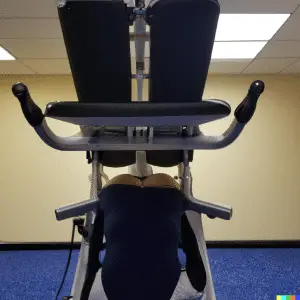Contents
What is an inversion table?
An inversion table is a device that allows you to suspend yourself upside down by your feet.
The idea behind inversion therapy is that by hanging upside down, you can decompress your spine and take pressure off of your discs and nerves. This can help to relieve pain and improve your posture and flexibility.
Inversion therapy has been used for centuries as a treatment for back pain. Today, it is gaining popularity as an alternative or complementary therapy for a variety of conditions, including:
- Back pain
- Disc problems
- Degenerative joint disease
- Headaches
- Poor circulation
- Scoliosis
- Muscle tension
How does an inversion table work?
Inversion therapy is a technique where you are suspended upside down to stretch the spine and relieve back pain. The idea is that by hanging upside down, the force of gravity pulls your body away from your spine. This results in a separation of your vertebrae, which takes the pressure off your discs and nerves.
There are a few different ways to do inversion therapy. The most common method is to use an inversion table. An inversion table is a padded table that you strap yourself into. Once you’re strapped in, you can slowly recline back until you’re upside down.
There are also inversion chairs and inversion boots. Inversion chairs look like regular chairs, except they have a mechanism that allows you to recline backward until you’re upside down. Inversion boots are similar to regular ski boots — they strap onto your feet and lower legs and allow you to hang upside down from a bar or other support.
What are the benefits of using an inversion table?
Inversion therapy is a technique where you are upside down or at an inverted angle while hanging by your feet, ankles, or thighs. The purpose of inversion therapy is to apply downward traction to your spine in order to stretch your back muscles and decompress your spine. This can help to relieve pressure on your discs and nerves, and also open up the spaces between your vertebrae.
There are many potential benefits of using an inversion table, including:
- Relief from back pain
- Reduced stress on the spine
- Improved blood circulation
- Reduced inflammation
- Strengthened core muscles
- Improved flexibility
How to Use an Inversion Table
An inversion table is a gravitational device that will help you stretch your spine and muscles. It is designed to decompress your spine and provide relief from back pain. Many people use inversion tables on a regular basis to improve their health, posture and well-being.
How to set up an inversion table
Most inversion tables will come with an instruction manual that will walk you through the set-up process step-by-step. Generally, setting up an inversion table is a relatively simple process that should only take a few minutes. Below is a brief overview of the steps involved in setting up an inversion table:
- Unpack the inversion table from its box and place it in the location where you plan to use it.
- Adjust the height of the inversion table to fit your body size. Most tables will have adjustments for different heights, usually ranging from 4 feet 6 inches to 6 feet 6 inches.
- Secure the safety straps around your ankles. These straps will keep you attached to the table and prevent you from falling off while inverted.
- Slowly lie back on the table and allow your body to become inverted. You may want to start with a slight inclination first and then work your way up to a complete inversion, depending on your comfort level.
How to use an inversion table
 An inversion table is a tool that can be used for spine decompression. It is a table that you strap yourself into and then it slowly tilts you backward. This essentially stretches your spine and can take pressure off of your vertebrae and discs. Inversion therapy has been used for centuries as a way to relieve back pain, but it has only become popular in recent years as more research has been done on its efficacy.
An inversion table is a tool that can be used for spine decompression. It is a table that you strap yourself into and then it slowly tilts you backward. This essentially stretches your spine and can take pressure off of your vertebrae and discs. Inversion therapy has been used for centuries as a way to relieve back pain, but it has only become popular in recent years as more research has been done on its efficacy.
There are many different brands and models of inversion tables, so it is important to do your research before purchasing one. You will also want to consult with your doctor to make sure that inversion therapy is right for you. Some people should not use inversion tables, such as those with high blood pressure, glaucoma, or pregnant women.
Once you have an inversion table, using it is relatively simple. You will need to follow the instructions that come with your specific table, but the basic process is as follows:
1) Position the inversion table so that it is level and stable. You don’t want it to tip over while you are inverted!
2) Adjust the height of the table so that your feet will be comfortable when straps are attached.
3) Place the padded part of the table against your back and secure the straps around your waist and thighs. Make sure the straps are tight enough so that you will not slip out but not so tight that they are uncomfortable.
4) Slowly tilt the table backward until you are at the desired angle of inverting. For beginners, this is usually around 60 degrees. 5) Hang there for anywhere from a few seconds to a few minutes depending on how long you feel comfortable inverting.
6) To come out of the inverting position, simply tilt the table back upright and release yourself from the straps. Be careful not to move too quickly or you may feel dizzy from the change in blood pressure
What are the precautions to take when using an inversion table?
There are several things to keep in mind when using an inversion table:
- Check with your doctor before using an inversion table if you have any health concerns, such as high blood pressure, glaucoma, or a herniated disc.
- Do not use an inversion table if you are pregnant.
- Use caution if you have any medical conditions that affect your balance, such as inner ear problems.
- Be sure to strap yourself in securely before inverting.
- Start slowly, inverting only a little at first, and increase the angle of inversion gradually over time.
Inversion Table Benefits
One of the most popular questions we get here at Spineinstituteny.com is “What are the benefits of using an inversion table?”. In this article, we’re going to take a look at the top benefits of using an inversion table on a regular basis.
How can an inversion table help with back pain?
An inversion table is a type of gravity-assisted therapy that can help people with back pain and sciatica. The theory is that by hanging upside down or at an inverted angle, the force of gravity can help to decompress the spine and take pressure off of the discs and nerves. This can provide relief from back pain and other conditions such as scoliosis.
There is some scientific evidence to support the use of inversion therapy for back pain. A 2010 study found that inversion therapy may be effective in treating chronic low back pain. However, more research is needed to confirm these findings.
If you’re considering using an inversion table for back pain, it’s important to talk to your doctor first. Inversion therapy may not be suitable for everyone, and there are some risks involved. These risks include stroke, spinal cord injury, and increased blood pressure.
How can an inversion table help with joint pain?
An inversion table is a device that allows you to suspend yourself upside down. The theory is that by hanging upside down, you can decompress your spine and take pressure off your joints. This can help to relieve joint pain, especially pain in the lower back.
One study found that people who used an inversion table for three minutes a day had significant reductions in lower back pain after eight weeks. Another study found that inversion therapy was helpful for people with neck pain.
Inversion therapy may also help to improve your range of motion and flexibility, and it may even help to reduce stress levels. If you have any chronic health conditions, be sure to talk to your doctor before using an inversion table.
How can an inversion table help with circulation?
Inversion therapy can help improve circulation by:
- Reducing the effects of gravity on the body
- Releasing muscle tension
- Improving flexibility
- Increasing blood flow to the brain
How can an inversion table help with stress?
An inversion table is a device that allows you to hang upside down, with your head below your heart. The theory behind inversion therapy is that by reversing the effects of gravity, you can take pressure off your spine and other joints, and reduce stress on your tissues and organs.
Inversion therapy has been used for centuries to treat back pain, and recent studies have shown that it may be an effective treatment for a variety of other conditions as well. Inversion therapy has been found to reduce stress hormones, improve circulation, relieve pressure on the discs in your spine, and stretch the muscles and ligaments around your spine.
One of the most common reasons people use inversion tables is to relieve back pain. Inversion therapy can take pressure off your discs and vertebrae, and help to decompress your spine. This can lead to significant relief from back pain, and may even help to prevent future injuries. If you suffer from chronic pain or have any other health concerns, check with your doctor before starting inversion therapy.
Frequently Asked Questions
How do I get the best results from an inversion table?
There are a few things you can do to get the best results from an inversion table. First, make sure you are using the table correctly. Second, be sure to warm up before using the table and stretch afterward. Third, use the table regularly for the best results.
How do I decompress my spine when I lay down?
There are a few ways that you can decompress your spine when you lay down. You can try lying on your back with your legs up against a wall, or you can try lying on your stomach with a pillow under your pelvis. You can also try lying on your side with a pillow between your knees.
How many times a week should you use an inversion table?
It is recommended that you use an inversion table for 10-15 minutes, 2-3 times per week.
spinal decompression, inversion table, spinal decompression therapy, inversion therapy, neck pain, inversion tables, spinal traction, traction force, few weeks, pain relief, spinal compression, many ways, back decompression, motorized traction, blood pressure, wide range, physical therapist, physical therapy, newsletter subscribe, shoulder pain, lumbar decompression, firm mattress, ideal firmness, medical care provider, spinal traction therapy, brief time period, crochet tech neck, chiropractic, sciatica, herniated disc, lower back pain, lower back, degeneration of the discs, chronic back pain, degenerative disk disease, bulging discs, chiropractors, nerve roots, laminectomy, whiplash, physiotherapist, back pain, pinched nerves, physical therapy, chiropractic adjustments

Dave Lee is the founder of Spine Institute NY, a huge fan of inversion therapy, a researcher, and an author.

